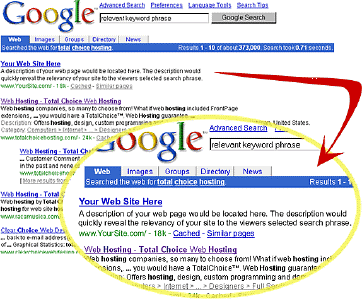Search Engine Marketing (aka SEM) has become the buzzphrase that is now heard all over the place. Here we provide an exact definition of what it refers to, and how it relates to both Web Search and Web Marketing and how 2M Digital Media Limited can help you achieve your online marketing aims.
Search Marketing is a part of business marketing efforts that is aimed at increasing traffic (the number of visitors) to the website from the search engines. Additionally, it addresses conversion (the percent of visitors who become buyers). The first is achieved by increasing search engine visibility, i.e. the position of your site in search engine results for certain keywords that people type in the search box to obtain these results.
For instance, if someone wants to find and buy a Samsung laptop, they will go to a search engine such as Google and type “samsung laptop” in the search box. Google will list, in this case, 22.5 million results. If you sell samsung laptops or offer any related services, your site may be listed among these 22,500,000 results. Here, everything depends on how deep you are. If you are on the first or second page of the search results, it’s more likely that such visibility will bring many visitors and customers from Google. If you are the 300th result, it’s unlikely that anyone at all will come to you from Google.
Together with the power and size of your banner / ad network, your affiliations and partnerships, SE visibility comprises a broader concept – Web visibility (aka online visibility).
Generally, there are two main methods of carrying out SEM: a) Search Engine Optimization (SEO) b) using pay-per-click and paid inclusion listing models.
Although paid inclusion and pay-per-click advertising methods seem like the fastest methods to search engine marketing, website should adopt more effective methods of search engine optimization which obtain better marketing of their website on search engines.
Organic rankings are results that you get for free. That is, you create Web copy and publish it, then after a certain period of time a search engine robot finds it (either by itself or as a result of your submission). Finally, the robot reads your content and puts your site into its index. Now your site will be found by this search engine when people query for some words contained within your pages. Obtained this way, your positions in the result list are called your “organic search engine rankings”.
Paid listings are different: pay a search engine and it guarantees the inclusion of your site in the index. Moreover, many search engines offer advanced pay-for-performance programs, such as showing your site / ad in the search results for keywords of your choice. These are the so-called “sponsored” results. Most commonly, you will have to pay a specified rate for each visitor that comes to your site from this search engine that clicks on these ads.
Mastering both methods and their proper combination can provide maximum search engine visibility. Because things keep changing, search engine marketers need to devote time to staying on top of the SEO industry and its trends.
The aim of SEM is not only to find a proper balance between organic and paid listings, but also to achieve maximum conversion of visitors into loyal customers. Nowadays SEM relies on the statement that it’s not the traffic itself that matters, but how targeted and convertible it is. The way your traffic converts also matters a lot – even more than your site rank on a search engine. You can rank worse than a competitor and yet the percentage of your visitors that turn into buyers can be high enough to actually outperform a competitor several times over.
The following are the main goals of Search Engine Marketing:
-
Improve Web visibility and get as much traffic as possible.
-
Improve traffic quality: get high rankings for exactly those keywords that bring visitors with the best conversion rate.
-
Decrease expenditures by switching off advertising for under performing keywords.
Methods used by Search Marketing
The main methods used for achieving the goals of Search marketing are Search Engine Optimization (for organic listings), Bid Management (for paid listings) and Web Analytics (for both types of listings).
Search Engine Optimization (SEO) is about changing the HTML code of your pages and the structure of your site in such a way that when an SE robot reads the site, it can understand that the pages have valuable content related to your keywords, and then rank them high. SEO also tells about ways to increase your link popularity – the number of links from other high-ranked pages to your site. This is important because most search engines consider your link popularity a vital ranking factor.
Bid Management is about controlling bids, i.e. the amount of money you spend maintaining your visibility in the sponsored listings. Usually you try to detect the best converting keywords and keyword groups, in order to increase bids on them; as well as decrease or take off bids on keywords that don’t break even. Attention also should be paid to leveraging your paid and organic listings, so to spend less on paid advertising campaigns when you get enough traffic from natural results, and invest in paid advertising when an algorithm changes or strong competitors force you out from the top positions in the organic listings.
Web Analytics is about getting, analyzing and using the information about your visitors, their details, their behavior on your site, the ways they have found your site, the efficiency of referrers and advertising, conversion rates, and, together with all that, eCommerce information.
If you would like to know more about the various fixed cost packages available, please telephone us on +44(0)1274-299180 or use the contact form.

